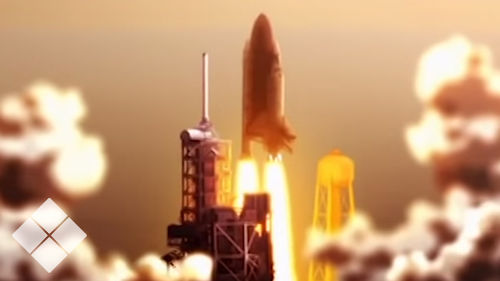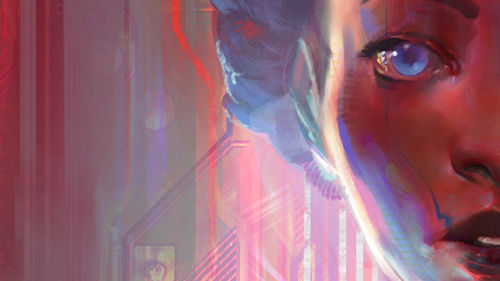Chronique:Canon Fodder - Giant Leaps

BY GRIMBROTHER ONE - 7/17/2015
ISSUE 33

Welcome back Terrans/Earthlings, and thanks for joining us for another week of Canon Fodder. For those of you who’ve been living under a (third) rock this week, an incredible achievement was unlocked in human history, as NASA’s New Horizons space probe made a historic flyby of Pluto. This mission, against unbelievable odds and across unfathomable distances, represented one of the most important scientific triumphs of our time.
Here around these parts, hundreds of hard-working developers were just as enthralled with the incoming images of Pluto and Charon as they normally are with Reach or Sanghelios. While we’re all passionate fiction fans, there are many of us who have their hearts steeped just as much in the “sci” as they do the “fi.” Yours truly is one such example. Many people don’t know that in a previous professional life, this founding fodder spent just under twenty years writing, developing, producing, and presenting science-based theatre and programming. I was even on the team that helped NASA develop and debut its original educational programming to support the then-upcoming (I suddenly feel old) International Space Station, or “Star Station One” as we knew it.
Growing up, it was a regular thing in our household to pour into the latest episode of Star Trek, or dive into diverse sci-fi epics such as Frank Herbert’s Dune, Larry Niven’s Ringworld, Orson Scott Card’s Ender’s Game, or C.S. Lewis’ enthralling Space Trilogy. Science fiction had a huge effect on my passion for science itself, and eventually, that passion opened up opportunities on both sides of the coin. One of my favorite pastimes is to watch the discussions that crop up on our forums regarding the “science” of the Halo universe. While it’s certainly fiction, and therein requires a healthy stretching of reality as we know it, it’s a blast to see fans dissect and discuss the huge influence science fact has had on the Halo narrative.
Textbook response
Throughout the past two decades, I’ve had the honor and pleasure to collaborate with and speak to some absolutely incredible minds in the scientific community, and in thinking about the unique focus for these particular pages this week, I thought it might be fun to grab a few opinions from some of them on the idea of this symbiotic relationship between science fact and science fiction. I hope you enjoy hearing their perspectives as much as I did!
Craig Hardgrove
Planetary scientist
Mars Curiosity rover science team member
Postdoctoral Research Scientist at Arizona State University
- "The study of science teaches us about the unknown and represents the culmination of humanity’s exploration of our world. On rare occasions, the boundaries of human knowledge and exploration are tangibly pushed outward, like this week when the New Horizons spacecraft took the very first high-resolution images of Pluto in human history. Textbooks are currently being rewritten. For some of us, this is a once-in-a-lifetime event. In between those moments, however, science-fiction is there for us to actually explore places we can’t yet go, and it touches upon the inherent desire we all have to know more about our world. Science-fiction stories encourage us all to think about how the world *could* be in a future where we’ve acquired more knowledge, or invented more fantastic technologies. We can ask important questions like where are we all, collectively, headed as a species? What are the consequences of all the possible technological, political, scientific, or biological actions or endeavors humans might take? Science-fiction, when infused with a touch of real science, lets us ponder these questions.
- "Something that I think is occasionally forgotten with respect to great science-fiction stories is that many of the best, most compelling tales came from the minds of scientists and engineers. Isaac Asimov studied biochemistry, Richard Heinlein worked on radio communications for the US Naval Academy, and Arthur C. Clarke was a radar specialist in the Royal Air Force. There are other, more contemporary, science fiction authors who studied science including Kurt Vonnegut (chemistry), and David Brin (PhD astrophysicist) just to name a few. As a scientist myself, I ate these stories up and I often think back on the sense of wonder, amazement, and curiosity that was instilled in me through science-fiction authors like these. Contained in their creations are stories and moments that felt grounded in reality, but offered a vision of what life *could* be like if certain choices were (or weren’t) made.
- “Right now, the future is close enough to allow us to think about what life would be like with things like full-immersion virtual reality, true artificial intelligence, or colonies on other planets. All of these possible futures contain ethical, societal, and political issues. But they stem from purely scientific concepts. I think this is the true power of science-fiction. You can’t take the science out of science-fiction, otherwise it’s just a completely made-up story, all fiction. And you can’t completely inundate a science-fiction story with science, otherwise it’s just a technical document with no heart, and not even necessarily fiction at all. But everyone wants a different balance of “science” and “fiction” in their science-fiction. Personally, I think this is where a story-telling medium like video games has a chance to really soar above books and movies. As opposed to books and movies, video games allow us to interact with game worlds and characters in very personal ways. We can make choices about what we spend our time doing, and what we choose to say or do with other characters. Even if those choices are made with space weapons held in front of our faces, we are still making choices and exploring rich, beautifully crafted worlds. In some games, the environment and world art itself tells a story that a player can experience just by walking around and exploring.
- "Halo’s ringworlds are a fantastic example. The idea of gigantic floating rings where the rotational speeds of the ring are sufficient to create artificial gravity at their surfaces were born in the science-fiction stories of Larry Niven and Arthur C. Clarke and are based on real scientific concepts of centripetal (or centrifugal, depending on your reference frame) force. These don’t exist in real life yet (they’re too big and expensive to make) but Halo took us there and simply by showing us these beautiful ringworlds, without actually saying a word, they made us question why there would be plant life, rivers and waterfalls, and what an alien race might actually want to do with these giant, spinning worlds. Video games can create beautiful environments and world art that speak to us visually, where scientific concepts can be embedded in the world such that the curious can pick up on them and the less curious can simply enjoy the show. A game can also be made such that those of us that want to read the history of the world can do just that (i.e. Mass Effect, Destiny), or if we just want to shoot aliens in the face we can do that too (i.e. Doom). I personally enjoy both, but I really like having the option to tailor it to my tastes (i.e. something like Deus Ex is a personal favorite). Science-fiction stories are incredibly powerful, and I can only hope we continue to see more great science-fiction in video games and across all forms of entertainment.”
Alan J Peche
Director of the Barlow Planetarium
University of Wisconsin-Fox Valley
- "In my opinion science fact (scifa) and science fiction (scifi) have had a very important and necessary symbiotic relationship. Science fiction creates a fictional world – complete with fictional technology – and, without overtly saying dares science to replicate it. The best examples come directly from the original Star Trek series: communicators and cell phones; the medical tricorder and CAT/MRI/PET technology. Personally, I mostly appreciate the science fiction that pushes the limits of science just a little out of the reality comfort zone – as the Victorian poet Robert Browning said “A man’s reach should exceed his grasp.”
- "There has been a conflict stirring by some members of the science community making the claim that science fiction isn’t holding up its end of the bargain as it used to – with books about dystopian futures or zombies – the once fertile ground of future technology is not so fertile any longer. As a response you have groups like the MIT Media Lab offering a workshop called Science Fiction to Science Fabrication that has participants engineering fictional technology from popular science fiction. It goes back to very foundation of the scifa/scifi relationship but endeavors to go one step further – to use scifi as a proving ground to investigate the possible unintended consequences of future tech.
- "Just recently, there was a great example of science fiction in the cinema: Interstellar. For me it was a perfect example of Browning’s statement. Interstellar pushed the limits of science ever so slightly just enough to make them uncomfortable while bringing up of some of those – usually forgotten – consequences of, usually, human nature. Don’t get me started on Gravity!"
Catherien Qualtrough
Astrophysicist
Science Communicator and Observatory Director at UNC Charlotte
- “One of the wonderful perks of being a scientist is being surrounded by people who know a lot about a wonderfully diverse set of scientific topics, from astrophysics and cosmology to nanotechnology. I have found that an increasingly large percentage of these scientists have a strong fascination with science fiction - often from a young age. I'd call myself one of the exceptions on that last point in that I didn't necessarily “grow up” on science fiction – other than my passion for Star Wars and early Battlestar Galactica of course! As time has gone on however, the deeper I go into science as a profession, the more interested I have become regarding the interplay between science and science fiction.
- “One of the strongest and most beneficial influences science fiction has is the way it often inspires young children to study science. It does it with great imagination, wonder, and excitement which is a great recipe for stoking a passion for STEM (Science, Technology, Engineering & Math) fields. It’s a passion that can sometimes be difficult to foster in a classroom alone.
- “And now we're seeing so much "real" science that looks like things we read about in or experience from science fiction. Everything from new worlds like we're revealing with NASA's New Horizons right now, to invisibility cloaks. Many of these ideas were conjured up in science fiction before we ever thought them possible. That creativity and imagination is incredibly valuable - you often need to be able to imagine something before you know how to do it. Creativity is something we don't always associate with science and scientists, but maybe science fiction also provides a creative outlet for the science-minded.
- “As someone that was actually originally inspired more by the beauty of the natural world and hard science than science fiction, it’s exciting to discover those same passions and inspirations can also be found in the seeds of science fiction. That's the beauty of the relationship between science and science fiction to me. It expands the reach of science to a much greater audience and captures that audience's insight and imaginations.”
Antonio Paris
Professor of Astronomy at St. Petersburg College
Director of Planetarium and Space Programs at the Museum of Science and Industry (Tampa, FL)
Chief Scientist at the Center for Planetary Science
- “There is no doubt that science fiction has shaped science; and science in turn has shaped science fiction. Prior to the space race, exploring planets like Mars was primarily observed through science fiction movies and comic books. Rockets like those illustrated in classic Flash Gordon for example, are basically the very same rockets used for space exploration today by NASA and the commercial space industry. In my opinion, there are many relationships that exist between science fiction and science. As an educator, I have personally seen how science fiction has inspired our younger generation into seeking careers in science - specifically in the space science field.
- “It is of course important to be careful with science fiction because it can sometimes lead people to think that all fiction will someday become realities. Recent movies like Interstellar resulted in an array of blogs and websites suggesting traveling through wormholes is around the corner - when in fact most scientist suggest its more than likely thousands or hundreds of thousands of years into the future. Science fiction is a fun and wonderful playground as long as we are careful not to overlap them in the wrong ways!”
A huge thanks to the folks above for sharing their thoughts! I can only hope that the coming years hold ever more opportunities for imagination and discovery, both within our favorite stories as well as in labs and observatories across this world and ever outward…
Patron Saint of AI

Don’t forget, coming up on July 27, 2015, you’ll be able to get your eyes and/or ears on the latest addition to the Halo story as Halo: Saint’s Testimony comes out! Penned by 343 Industries’ own Frank O’Connor and brought to you by our friends at Simon & Schuster, this digital short will reintroduce fans to the artificial intelligence Iona, and treads some intriguing new territory in Halo storytelling. Don’t miss it!
Channel on the go

At San Diego Comic Con, we announced that the Halo Channel is now available on mobile for iOS and Android platforms! Now it’s easier than ever to get your Halo fiction fix on the go, with tons of great story related content available for your viewing pleasure. As a special treat this week, we’ve featured a fantastic Community Creation by Unyshek, who put together an absolutely epic look at the big picture of the Halo story to get fellow fans primed and ready for Halo 5: Guardians. If you haven’t seen it yet, pull up the Channel and check it out!
And so that brings us to a close this week. Thanks for joining us for a unique issue indeed, we hope you’ll be back for some more delicious lore-morsels next time!
Until next week… Live well, play Halo, and remember that we choose to go to Pluto and do these other things not because they are easy, but because they are hard.
-Grim
New universe entries this week!
The Shadow is a Covenant transport designed to carry troops and vehicles into combat.
The Brute Shot is a Jiralhanae-devised explosive projectile weapon fitted with a razor-sharp, stock-mounted blade. It is intended to terrify as much as it is to kill.